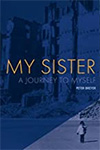My Sister, A Journey to Myself by Peter Breyer (India)
 My Sister, A Journey to Myself
My Sister, A Journey to Myself
by Peter Breyer (India 1965-67)
Miah Books
263 pages
2010
$11.50 (paperback)
Reviewed by Stephen Foehr (Ethiopia 1965-67)
•
Peter Breyer wrote this family memoir when he was a fifty-nine-year-old American white male with a professional career, former Peace Corps volunteer in India, a family man, a Christian who attended Bible study classes at his wife’s Black church. The story recounts his search for a German half-sister he never knew he had, and how the journey brought him face-to-face with the conundrum — how can we do this to each other?
Breyer’s parents were German. His mother was well educated from an upper-middle-class Jewish family. His father came from the working class and was a vocal anti-Hitler critic, which brought him to the attention of Nazi authorities. His parents, Max and Marcelle, fled Germany in 1936, when the crackdown on Jews and dissidents was fully underway. Sixty-five years later, Peter stepped into that history, and found himself smack-dab in an existential quandary.
We define our life through the choices we make, choices that are influenced by decisions made in previous decades by family and by strangers. That is the meme of history. How mega history (the tide of Nazism) becomes microhistory (Peter’s journey) is a universal story we all can share.
We think we are safe from the actions of generations before, especially if those people lived in a faraway country and in a seemingly different context. As Peter discovered, we cannot escape human nature — but we can make better decisions, take more admirable actions, put ourselves in our brother’s and sisters’ shoes, and not repeat evil lessons of history.
Peter writes with compelling frankness and personal honesty, which makes him appealing and lends authenticity to the narrative. In many places the book reads like an extended family letter, with details of minimal interest to nonfamily, yet the passages and the references to his Bible classes and church community, make him less a stranger to the reader. He addresses the proposition of how to fit the uncomfortable past into the present, at the risk of upsetting, or at least unbalancing, the applecart, a proposition resonating anew as Americans once again confront the country’s racial history.
He tells how meeting his German relatives (an uncle who wore the Nazi uniform) had a powerful impact on him. The conversations were . . .
. . . like seeds that were to lay dormant for many years but would later blossom and lead to experiences and feelings of self-discovery that I never could have imagined a the time. As an older man, I have come to understand that many of our actions of former years, although appearing haphazard and undirected at the time, fit into a pattern of expressing who we are and what we want out of life.
In his research, Peter learned that a police battalion composed of men too unfit or too old to serve in the military and who fairly representative of the general German male population, these ordinary Germans, murdered close of half a million Jews rounded up town by town, village by village. “They were not forced into the battalions to shoot Jews,” Peter writes. “They were basically “good people” who believed they were doing the right thing.”
How could so-called good people act in such a manner? he asks. “Well,” he answered, “were all those who mistreated and killed Native Americans evil? I don’t think so, since it was an ingrained part of American culture at the time. The assumption by my contemporaries, that they, of course, would never do such a thing, was easy to say in this time and place.”
Which begs the question, What is ingrained in our present American culture that fosters the deadly racism, the social and economic injustices of fellow Americans, the sense of grievances of one stratus of Americans against their country citizens?
Peter admits wavering between two opposing and extreme views; to be open and forgiving and not judgmental of the Germans struggling to survive in the murderous Nazi regime, and his gut reaction that wants “justice, revenge, and retribution — that somebody must pay for “what they did to us.” Crimes like that cannot go unpunished, even it takes a thousand years.”
Is Peter prescience of America’s future?
Peter’s search for his half-sister? He found the woman, Anita, in Germany. She wasn’t his biological half-sister. Peter’s father, a good friend of Anita’s mother, had married the mother for somewhat complicated bureaucratic reasons so Anita and her mother could reunite with her biological, a foreign correspondent, in China. Still, Peter was very happy to make her acquaintance.
•
Stephen Foehr (Ethiopia 1965-67) is the author of numerous nonfiction and fiction books. His latest novel, Stealing Fortune’s Brick, the Audacious Tea Heist, was published in July 2020. His newest novel, Warrior Love, Silas Loves Lili Weirdly Lili Loves Silas, will be published in March 2021.
To help understand how “good Germans” could have committed murder and other heinous acts during the 1933-1945 period of the Third Reich, readers may want to consult the first of three volumes written about this period by British historian Richard J. Evans: The Coming of the Third Reich. It examines the period of the Second Reich (1871-1933) and the political parties, before and after World War I, which gave rise to the totalitarian fervor of National Socialsm (the Nazi party) and Adolph Hitler.
Robert Hamilton (Bahar Dar, Ethiopia; 1965-67)